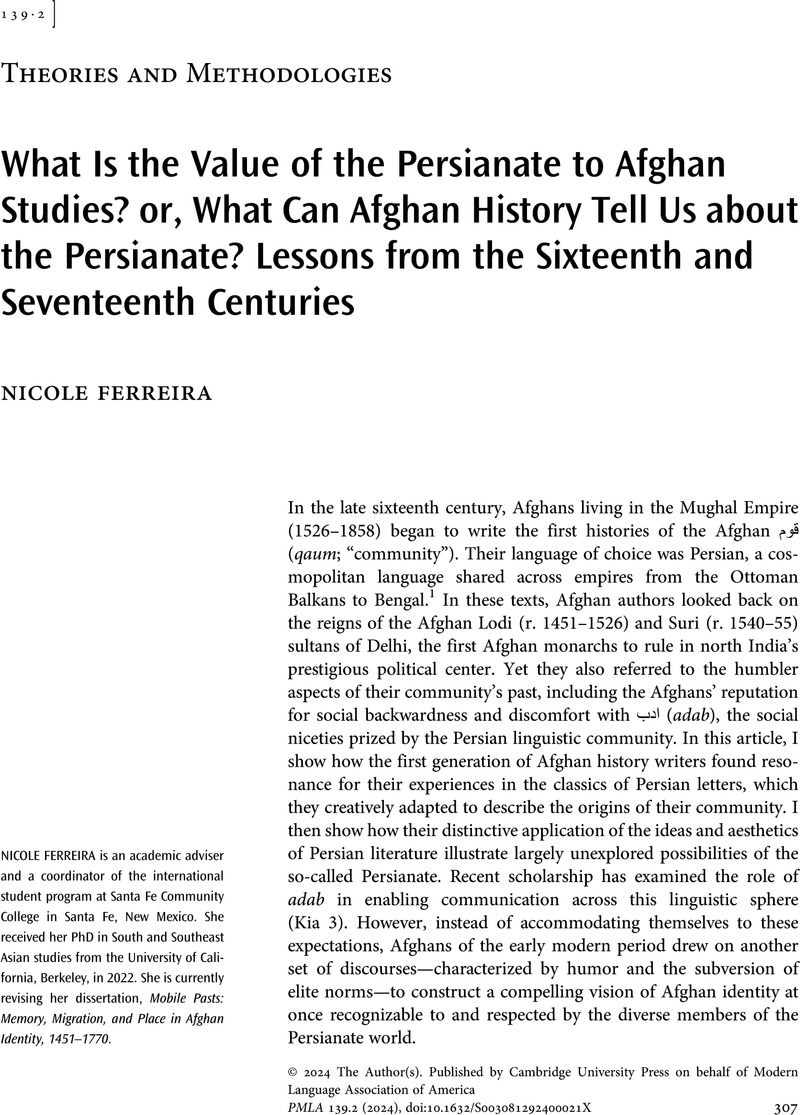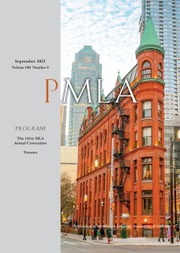No CrossRef data available.
Article contents
What Is the Value of the Persianate to Afghan Studies? or, What Can Afghan History Tell Us about the Persianate? Lessons from the Sixteenth and Seventeenth Centuries
Published online by Cambridge University Press: 26 July 2024
Abstract
An abstract is not available for this content so a preview has been provided. Please use the Get access link above for information on how to access this content.

- Type
- Theories and Methodologies
- Information
- Copyright
- Copyright © 2024 The Author(s). Published by Cambridge University Press on behalf of Modern Language Association of America
References
Works Cited
Ahmed, Shahab. What Is Islam? The Importance of Being Islamic. Princeton UP, 2015.CrossRefGoogle Scholar
Alam, Muzaffar. The Languages of Political Islam: India, 1200–1800. U of Chicago P, 2004.Google Scholar
Ali, Athar. Army Organisation under the Sultans of Delhi (Thirteenth and Fourteenth Century). 1987. Aligarh Muslim U, PhD dissertation.Google Scholar
Bosworth, C. E. “Menhāj-e Serāj.” Encyclopaedia Iranica, 2010, www.iranicaonline.org/articles/menhaj-seraj. Accessed 5 Sept. 2023.Google Scholar
Darweza, Akhund. تذکرة الابرار و الاشرار [Tazkirat al-Abrar wa al-Ashrar]. Manzoor-e Aam Press, 1940.Google Scholar
Eaton, Richard. India in the Persianate Age, 1000–1765. U of California P, 2019.CrossRefGoogle Scholar
Green, Nile. Making Space: Sufis and Settlers in Early Modern India. Oxford UP, 2012.CrossRefGoogle Scholar
Green, Nile, editor. The Persianate World: The Frontiers of a Eurasian Lingua Franca. U of California P, 2019.CrossRefGoogle Scholar
Hardy, Peter. Historians of Medieval India: Studies in Indo-Muslim Historical Writing. Munshiram Manoharlal Publishers, 1997.Google Scholar
Ho, Engseng. The Graves of Tarim: Genealogy and Mobility across the Indian Ocean. U of California P, 2006.CrossRefGoogle Scholar
Kabir, Muhammad. افسانه شاهان [Afsana-yi Shahan]. British Library, London, MS Add. 24409.Google Scholar
Kia, Mana. Persianate Selves: Memories of Place and Origin before Nationalism. Stanford UP, 2020.CrossRefGoogle Scholar
Kumar, Sunil. “The Ignored Elites: Turks, Mongols, and a Persian Secretarial Class in the Early Delhi Sultanate.” Modern Asian Studies, vol. 43, no. 1, 2009, pp. 45–77.CrossRefGoogle Scholar
Mushtaqi, Rizq Allah. واقعات مشتاقی [Waqi‘at-i Mushtaqi]. Edited by Siddiqui, Iqtidar Husain and Siddiqi, Waqarul Hasan, Rampur Raza Library, 2002.Google Scholar
Sa‘di of Shiraz, Shaykh Mushrifuddin. The Gulistan (Rose Garden) of Sa‘di. Translated by Thackston, Wheeler M., Ibex Publishers, 2008.Google Scholar
Siddiqui, Iqtidar Husain. Introduction. Waqi'at-e Mushtaqui of Shaikh Rizq Ullah Mushtaqui, translated and edited by Siddiqui, Indian Council of Historical Research and Northern Book Centre, 1993, pp. xi–xxxi.Google Scholar
Thackston, Wheeler M. Translator's preface. Sa‘di of Shiraz, pp. iv–xi.Google Scholar


